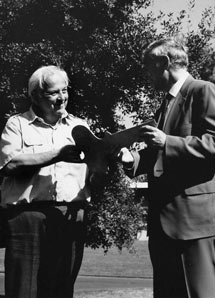
Handy Links
SLAC News Center
SLAC Today
- Subscribe
- Archives: Feb 2006-May 20, 2011
- Archives: May 23, 2011 and later
- Submit Feedback or Story Ideas
- About SLAC Today
SLAC News
Lab News
- Interactions
- Lightsources.org
- ILC NewsLine
- Int'l Science Grid This Week
- Fermilab Today
- Berkeley Lab News
- @brookhaven TODAY
- DOE Pulse
- CERN Courier
- DESY inForm
- US / LHC
SLAC Links
- Emergency
- Safety
- Policy Repository
- Site Entry Form

- Site Maps
- M & O Review
- Computing Status & Calendar
- SLAC Colloquium
- SLACspeak
- SLACspace
- SLAC Logo
- Café Menu
- Flea Market
- Web E-mail
- Marguerite Shuttle
- Discount Commuter Passes
-
Award Reporting Form
- SPIRES
- SciDoc
- Activity Groups
- Library
Stanford
Around the Bay
Congratulations, SPEAR: 20 Years as Dedicated Lightsource
Twenty years ago this month, SPEAR (the Stanford Positron-Electron Accelerating Ring) retired from the particle-smashing business and started a second career as SPEAR, an electron storage ring dedicated to the Stanford Synchrotron Radiation Lightsource (then the Stanford Synchrotron Radiation Laboratory). The dedication ceremony included the handing over of a symbolic SPEAR "key" by then-SLAC Director Burton Richter to Arthur Bienenstock, who was SSRL Director at the time.
SPEAR initially began operations in 1972, and it didn't take long for discoveries at the ring to revolutionize particle physics. In 1974 Richter discovered the J/psi particle, which led to confirmation of the existence of the charm quark, and in 1976 SLAC physicist Martin Perl found the tau lepton, the electron's heavier relative. But even while Richter and Perl were gathering their data and making their Nobel-winning discoveries, synchrotron radiation emitted by SPEAR's electron and positron beams was being put to good use by the Stanford Synchrotron Radiation Project, with five experimental stations sharing a beamline.
By 1977 the SSRP comprised two beamlines and nine experimental stations and traded in its "P" for an "L," becoming the Stanford Synchrotron Radiation Laboratory. Demand for synchrotron radiation continued to grow. The addition of an injector to SPEAR in 1990 meant that the ring was no longer dependent on the linac for electrons, and paved the way for the creation of a dedicated lightsource for SSRL.
"Burt Richter's transfer of SPEAR to SSRL, coupled with the completion of the SPEAR injector, was a major event," Bienenstock said. Following the transfer, " SSRL was able to focus quite successfully on making the ring function reliably and effectively for synchrotron radiation research, while not interfering with—or getting interference from—[Stanford Linear Collider] operation. Both photon science and high energy physics at the site profited enormously as a result."
And now, 20 years later, SSRL is the Stanford Synchrotron Radiation Lightsource. Its Nobel prize-winning ways continue, albeit in chemistry rather than physics. New SSRL Director Chi-Chang Kao said he is looking forward to the future.
"With the SPEAR-3 upgrade nearing completion, SSRL is now poised to make a major impact to a wide range of scientific questions and problems facing society today," Kao said, "as well as support the growth of the laboratory in the coming decade. I am very excited to join SSRL at this point in its history."
SPEAR is still demonstrating that a second career can be as fruitful as the first.
—Lori Ann White
SLAC Today, October 12, 2010
